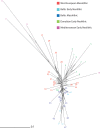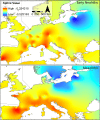Ornaments reveal resistance of North European cultures to the spread of farming
- PMID: 25853888
- PMCID: PMC4390204
- DOI: 10.1371/journal.pone.0121166
Ornaments reveal resistance of North European cultures to the spread of farming
Abstract
The transition to farming is the process by which human groups switched from hunting and gathering wild resources to food production. Understanding how and to what extent the spreading of farming communities from the Near East had an impact on indigenous foraging populations in Europe has been the subject of lively debates for decades. Ethnographic and archaeological studies have shown that population replacement and admixture, trade, and long distance diffusion of cultural traits lead to detectable changes in symbolic codes expressed by associations of ornaments on the human body. Here we use personal ornaments to document changes in cultural geography during the Mesolithic-Neolithic transition. We submitted a binary matrix of 224 bead-types found at 212 European Mesolithic and 222 Early Neolithic stratigraphic units to a series of spatial and multivariate analyses. Our results reveal consistent diachronic and geographical trends in the use of personal ornaments during the Neolithisation. Adoption of novel bead-types combined with selective appropriation of old attires by incoming farmers is identified in Southern and Central Europe while cultural resistance leading to the nearly exclusive persistence of indigenous personal ornaments characterizes Northern Europe. We argue that this pattern reflects two distinct cultural trajectories with different potential for gene flow.
Conflict of interest statement
Figures




Similar articles
-
The shaping of social and symbolic capital during the transition to farming in the Western Mediterranean: Archaeological network analyses of pottery decorations and personal ornaments.PLoS One. 2023 Nov 8;18(11):e0294111. doi: 10.1371/journal.pone.0294111. eCollection 2023. PLoS One. 2023. PMID: 37939080 Free PMC article.
-
Symbols in motion: Flexible cultural boundaries and the fast spread of the Neolithic in the western Mediterranean.PLoS One. 2018 May 1;13(5):e0196488. doi: 10.1371/journal.pone.0196488. eCollection 2018. PLoS One. 2018. PMID: 29715284 Free PMC article.
-
Craniometric data support a mosaic model of demic and cultural Neolithic diffusion to outlying regions of Europe.Proc Biol Sci. 2011 Oct 7;278(1720):2874-80. doi: 10.1098/rspb.2010.2678. Epub 2011 Feb 23. Proc Biol Sci. 2011. PMID: 21345869 Free PMC article.
-
Iberia: population genetics, anthropology, and linguistics.Hum Biol. 1999 Oct;71(5):725-43. Hum Biol. 1999. PMID: 10510567 Review.
-
Last hunter-gatherers and first farmers of Europe.C R Biol. 2011 Mar;334(3):182-9. doi: 10.1016/j.crvi.2010.12.010. C R Biol. 2011. PMID: 21377612 Review.
Cited by
-
The shaping of social and symbolic capital during the transition to farming in the Western Mediterranean: Archaeological network analyses of pottery decorations and personal ornaments.PLoS One. 2023 Nov 8;18(11):e0294111. doi: 10.1371/journal.pone.0294111. eCollection 2023. PLoS One. 2023. PMID: 37939080 Free PMC article.
-
Multivariate analyses of Aurignacian and Gravettian personal ornaments support cultural continuity in the Early Upper Palaeolithic.PLoS One. 2025 Jun 4;20(6):e0323148. doi: 10.1371/journal.pone.0323148. eCollection 2025. PLoS One. 2025. PMID: 40465694 Free PMC article.
-
A supervised multiclass framework for mineral classification of Iberian beads.PLoS One. 2024 Jul 10;19(7):e0302563. doi: 10.1371/journal.pone.0302563. eCollection 2024. PLoS One. 2024. PMID: 38985774 Free PMC article.
-
The Neolithic Transition in the Baltic Was Not Driven by Admixture with Early European Farmers.Curr Biol. 2017 Feb 20;27(4):576-582. doi: 10.1016/j.cub.2016.12.060. Epub 2017 Feb 2. Curr Biol. 2017. PMID: 28162894 Free PMC article.
-
Evidence from personal ornaments suggest nine distinct cultural groups between 34,000 and 24,000 years ago in Europe.Nat Hum Behav. 2024 Mar;8(3):431-444. doi: 10.1038/s41562-023-01803-6. Epub 2024 Jan 29. Nat Hum Behav. 2024. PMID: 38287173
References
-
- Ammerman AJ, Cavalli-Sforza LL. The Neolithic transition and the genetics of population in Europe Princeton: Princeton University Press; 1984.
-
- Bar-Yosef 0. East to West—Agricultural origins and dispersal into Europe. Curr Anthropol. 2011; 45: S1–S3.
-
- Özdoğan M. Archaeological Evidence on the Westward Expansion of Farming Communities from Eastern Anatolia to the Aegean and the Balkans. Curr Anthropol. 2001; 52: S415–S430. 10.1086/658895 - DOI
-
- Tresset A, Vigne JD. Substitution of species, techniques and symbols at the Mesolithic-Neolithic transition in Western Europe. Proc Br Acad. 2007; 144: 189–210.
Publication types
MeSH terms
LinkOut - more resources
Full Text Sources
Other Literature Sources

